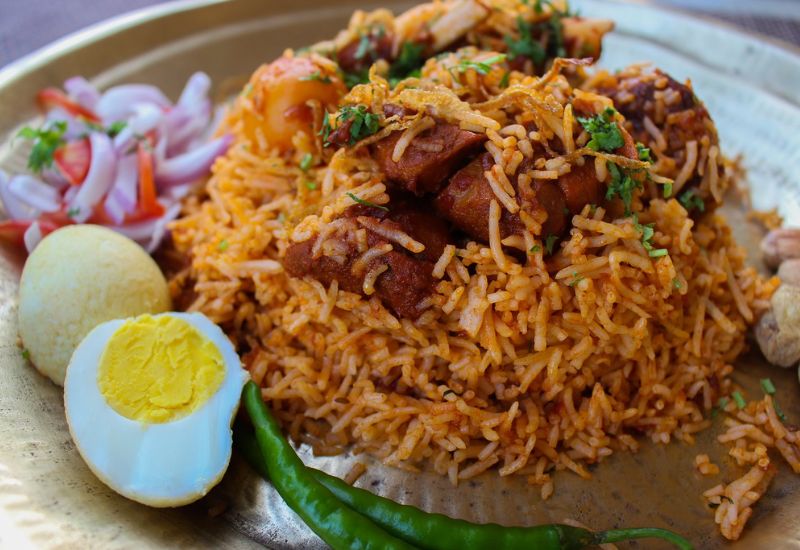Introduction
Welcome to a flavourful journey through the heart of South Indian cuisine, where we explore the delightful nuances of Ambur and Arcot biryanis. These dishes, originating from the vibrant state of Tamil Nadu, are not just staples of Indian cuisine; they’re emblematic of the rich cultural and historical tapestry that defines the region.
In this blog, we’ll delve into the origins, ingredients, cooking methods, and unique aspects of Ambur and Arcot biryanis. We’ll also examine how geography and history have shaped these culinary treasures, offering more than just a taste but an experience steeped in tradition. Join us as we unravel the stories behind these exquisite biryanis and discover what makes each one distinctively tantalising.
The Historical Roots
Ambur Biryani: The Essence of a Small Town

Ambur, a small town in the Vellore district of Tamil Nadu, has a history intertwined with the Nawabs of Arcot. Its proximity to Bangalore and Chennai made it a significant spot on the trading route, influencing its cuisine with various cultural interactions. Ambur Biryani emerged as a symbol of the town’s culinary identity, known for its simplicity and distinctive taste.
Arcot Biryani: The Royal Heritage
Arcot Biryani, meanwhile, has a regal lineage. Originating from the royal kitchens of the Nawabs of Carnatic, it was a dish that symbolised opulence. The Nawabs, with their Persian influences, introduced a biryani that was rich in spices and flavour, contrasting the more straightforward preparation of Ambur Biryani.
The Ingredients: A Tale of Two Recipes
Rice: The Foundation
- Ambur Biryani: Uses Seeraga samba rice, a short-grained variety that is native to South India. This rice is known for its ability to absorb flavours well.
- Arcot Biryani: Prefers long-grained Basmati rice, renowned for its fragrance and non-sticky texture after cooking.
Meat: The Protein Choice
- Ambur Biryani: Typically made with chicken or mutton. The meat is marinated but not as extensively as in Arcot Biryani.
- Arcot Biryani: This also uses chicken or mutton, with an emphasis on a longer marination period to infuse more flavours into the meat.
Spices: The Flavor Makers
- Ambur Biryani: Characterized by a modest use of spices, with star anise and stone flower being the unique additions.
- Arcot Biryani: A more lavish use of whole spices like cloves, cardamom, cinnamon, and bay leaves, creating a more potent flavour profile.
The Cooking Process: An Art in Itself

The Technique
- Ambur Biryani: Employs the ‘Dum’ method, where the biryani is cooked on a low flame, allowing the rice and meat to cook evenly in their own steam.
- Arcot Biryani: This also uses the ‘Dum’ technique but involves a more complex layering process, with partially cooked rice and meat layered alternately.
The Flavor Infusion
- Ambur Biryani: Relies on the natural flavours of the ingredients, with less emphasis on additional seasoning.
- Arcot Biryani: Often includes a touch of saffron and sometimes coconut milk, adding richness and complexity to the dish.
Serving and Pairings: Completing the Meal
Accompaniments
- Ambur Biryani: Commonly served with a side of cucumber raita and brinjal gravy.
- Arcot Biryani: Often accompanied by a mint chutney, onion raita, and a boiled egg.
Presentation
- Ambur Biryani: Typically served in a communal dish, emphasising the communal aspect of the meal.
- Arcot Biryani: Served individually, often garnished with fried onions, boiled eggs, and fresh coriander.
Cultural Significance: More than Just Food

Ambur and Arcot biryanis hold a special place in the hearts of the people from these regions. They are not just dishes but symbols of cultural identity and pride. Festivals, weddings, and other celebrations are incomplete without these biryanis, reflecting the deep-rooted traditions associated with them.
| Feature | Ambur Biryani | Arcot Biryani |
| Rice Type | Seeraga Samba | Basmati |
| Meat | Chicken/Mutton | Chicken/Mutton |
| Marination | Less extensive | More extensive |
| Spice level | Moderate | Moderate |
| Cooking Technique | ‘Dum’ method – simple | ‘Dum’ method – layered |
| Flavour Profile | Subtle | Aromatic |
| Accompaniments | Cucumber raita, brinjal gravy | Mint chutney, onion raita |
Sulthan’s Biryani: A Symphony of Flavours
Sulthan’s Biryani, acclaimed as one of Chennai’s finest biryani destinations, is a culinary haven for those who cherish biryanis’ diverse and rich flavours. Echoing the essence of our blog on Ambur and Arcot-style biryanis, Sulthan offers an array of biryani varieties that cater to every palate.
From the robust and flavourful chicken and mutton biryanis to regional specialities like Hyderabadi, Lucknawi, and Kolkata-style biryanis, this restaurant is a testament to India’s biryani diversity.
Also Check
History of hyderabadi biryani
Conclusion
To wrap up, our exploration into the Ambur and Arcot biryanis takes us through a rich tapestry of flavours and into the heart of South Indian culture and history.
These biryanis, each with their distinct character, showcase the diversity and culinary brilliance of the region. Whether it’s the subtly spiced Ambur Biryani or the aromatic and richer Arcot Biryani, both represent the essence of traditional Indian cooking.




